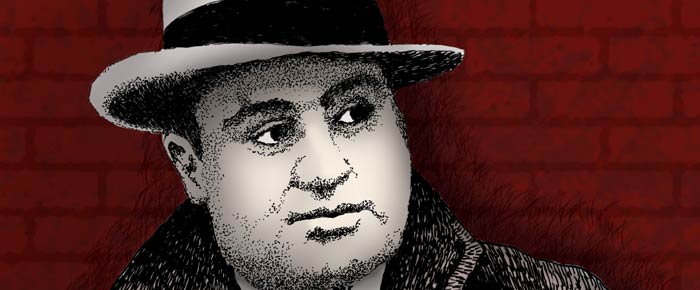
Most major cities around the world have assigned groups of law enforcement officers to identify, target and dismantle Organized Crime Syndicates. Usually, the overall thrust of the police's efforts is to take down an OCS through the arrest and conviction of its leaders. Often it can take years to completely dismantle powerful OCS structures, while sadly some OCS can thrive despite law enforcement's best efforts. The challenge of getting to the top is often based upon bridging the distance between the perpetrators of the crime and the directors who profit from it. How is it possible to get to the top of an OCS knowing that criminal associates would rather go to jail than "rat out" their brethren, particularly their bosses? This is an age old question that fortunately has an age old answer: Al Capone.
Ultimately the conviction of Capone (aka Scarface) was much more complex than an isolated criminal tax case. The Internal Revenue Service recently released the investigative report revealing hundreds of details pertaining to the overall case against Capone. That report, in conjunction with a more recently discovered memoir1 written by the lead IRS agent assigned to the Capone investigation, demonstrates just how difficult it really was to capture Public Enemy Number 1. Of particular relevance today are the financial investigative techniques used to convict Capone in the 1930s that encompass methods today's law enforcement can use.
The techniques used naturally included some of the methods one would expect. Financial investigators analyzed voluminous business records and tried to track Capone's extravagant expenditures, but that was not nearly sufficient. To finally get Capone it required them to uncover nominee bank accounts, trace hidden Western Union money transfers, reveal straw buyers, locate and co-opt reluctant witnesses, as well as utilize informants and undercover agents. All the while, these valiant investigators dealt with death threats, attempted jury rigging and overt witness intimidation.
The IRS could not and did not do this alone. Reviewing the steps of how Capone was caught illustrates how banks and money services businesses were abused to hide Capone's money, in much the same way as in today's environment. As you will see, Capone's ill-gotten profits were transacted through a small bank and Western Union, just not in his name. But first, to understand why the Federal government went after a Chicago mobster, it helps to explain who he really was at that time.
Who was Al Capone?
Over the years, Hollywood has glamorized 1920s gangsters and sometimes even painted Al Capone as a folk hero of sorts. In reality, Capone oversaw a large and vicious criminal syndicate which operated with impunity throughout Chicago. The movies portrayed some of Capone's crimes accurately, from bootlegging beer and whiskey to the operation of illegal casinos and prostitution houses. Yet Capone's gang also branched out into other more nefarious activities, including extortion, kidnapping and racketeering. Hollywood seemed to overlook the fact that Capone and his syndicate fought their way to the top of Chicago's criminal gangs by murdering between 40–50 rivals. Clearly this sort of mayhem was a major problem, not only for the rival gangs, but also for the ordinary citizens of Chicago. Citizens were outraged with the 1929 Valentine's Day Massacre, blaming the hit squarely on Capone's camp.
Capone's downfall began with the self-appointed Chicago Crime Commission (CCC), a group of six wealthy businessmen. Fearing they had no viable local option, the CCC pled directly to President Herbert Hoover to bring in the resources of the Federal government. President Hoover later kicked off a very public rejoinder by proclaiming Capone "Public Enemy Number 1." Hoover then directed several Federal agencies including the Bureau of Prohibition to focus on Capone and his OCS. Ultimately though, it was the IRS Intelligence Unit (the precursor to IRS Criminal Investigation) which was the key to the successful incarceration of Capone. Based upon Hoover's edict, IRS Headquarters quickly enlisted Special Agent Frank Wilson to move to Chicago and lead a team of IRS Special Agents to "Get Capone."2 The challenges Wilson faced then were significant and astonishingly similar to the challenges of investigating OCS leaders today.
Where to begin?
Wilson promptly established that Capone lived a life of luxury, though according to known records Capone only owned a modest house in the suburbs of Chicago. He had no other assets in his name, no bank accounts, no stock and Capone never filed tax returns. Wilson noted in his memoir, "…there was no clue that a dollar from the big gambling palaces, the horse parlors, the brothels or the bootleg joints ever directly or indirectly reached his pockets."1 Capone had the audacity to spend the winters in Miami, living in a mansion on the intracoastal waterway.
Capone's downfall began with the self appointed Chicago Crime Commission, a group of six wealthy businessmen
In an unorthodox arrangement, certain newspaper reporters had ready access to Capone, detailing parts of his gangster life and painting him as a daring rebel. It was surprisingly easy to learn that Capone threw lavish parties, spent extravagantly, and doled out gifts (and bribes) with little difficulty. Yet the most problematic issue for Wilson was there were no witnesses for Capone's expenditures or income.
Wilson was painfully aware that potential witnesses knew about Capone's financial activities, but they were also legitimately scared to death to talk about it. One potential witness told Wilson, "If I tell you about Capone and that raid, Scarface will either bump me off or hurt my family…" This may sound sadly repetitive to today's task force officers. So how would you proceed at this point? Let's find out how Wilson did it.
Finding Evidence
Wilson had to overcome two obstacles to get Capone. First, he had to find a way to get financial evidence when most of Capone's transactions were in cash. Second, once Wilson located such evidence, he needed to find a way to persuade witnesses to testify against Capone.
Just as today, criminal tax cases required proof that traceable funds in particular years were, in fact, income resulting in a tax due and owing. Wilson explained in his memoir, "Getting to the bottom of the financial activities of the Capone Syndicate and establishing the taxable income of Scarface was something like solving several terribly tough jigsaw puzzles, each puzzle representing a different branch of the syndicate business."1 While the exact chronology of the case is not known, it is acknowledged that Wilson began his efforts sometime in 1929. Wilson and his team worked for nearly a year attempting to find transactions that would link income to Capone. Wilson lamented, "[We] legged it to the banks, credit agencies and loads of other potential sources, trying to find some record of business transactions involving Scarface. Not a tumble."1
Since he had little luck with Capone individually, Wilson began the next logical step, an investigation within Capone's OCS. Wilson's team turned their attention to potential tax violations by Capone's lieutenants. As a general rule, fellow criminals often have a better recollection of the facts when faced with lengthy prison sentences themselves, especially while their leaders remain free. The IRS team garnered initial success with this strategy and speedily obtained pleas or convictions for income tax violations on Capone's inner circle. Capone's second in command, Jack Guzik (responsible for gambling and prostitution), was sentenced to five years; Ralph Capone (Al's older brother and responsible for beer distribution and breweries) received a three year sentence; and Frank Nitto (the enforcer and responsible for alcohol distribution) was sentenced to 18 months. Unfortunately, none of these men turned against Capone.
The First Big Break
In the second year of the investigation, Wilson and his team reviewed evidence previously overlooked from prior searches, voluminous memorandums and other reports, with little success. Late one evening, Wilson fortuitously found the break he needed. He accidentally discovered some dusty brown envelopes tied with string in what he thought to be an unused filing cabinet. Wilson noted, "Something prompted me to examine it so I snipped the string and found myself holding three ledgers, black ones with red corners."1 After speedily analyzing the ledgers Wilson calculated that they represented nearly $540,000 in net profits likely from one of Capone's casinos. It was a significant discovery but it was only half of his goal. His real challenge would be the other half, finding witnesses to testify about them.
Wilson learned that the ledgers had been seized during a raid at the Hawthorne Smoke Shop (HSS) in 1926. A series of subsequent interviews revealed that the HSS was a front business for the largest gambling palace in Cicero, a gritty suburb of Chicago. Wilson arranged a number of witnesses to both introduce the ledgers as evidence and provide other vital testimony. One key witness recalled that early on in the search Capone chirped, "It ought to be my party. I own the place."1 While that was helpful, none of them could testify about the most important component of all, the relevance of the entries in the journals.
Wilson believed that the majority of entries in the ledger were made in the same handwriting, but whose was it? Wilson directed a laborious process of gathering handwriting samples of every known hoodlum in Chicago. Wilson noted that he took samples from "voting registers in the wards, from savings accounts, from police courts and from the bonds they signed when they were pinched."1 By the process of elimination, they found a match with the ledger on a single deposit slip from a bank in Cicero. The witness was Lew Shumway, though predictably, he was nowhere to be found.
Wilson suspected that Capone, who was in Miami for the winter, kept Shumway close-by. Wilson rushed to Florida and discovered Shumway working in the cashier's department of a dog track. Wilson approached Shumway and gave him a tough choice. Choose Capone or choose the government with Wilson's promise of protection. Shumway chose the government and provided essential testimony for the case. Shumway explained that Capone was one of the actual owners of the HSS. Shumway was able to account for 18 months of daily casino profits and the consequential income that could be credited to Capone individually. Wilson knew that he finally had the witness to get Capone and recollected, "That night I spirited Shumway out of Miami so that even his wife thought he was going to a sick relative in Oklahoma."1
More Witnesses
While Shumway was certainly a high value witness for the case, other sources of financial evidence were being pursued at the same time. Two intrepid IRS agents were contacting local banks to see if they could find links to Capone's gang. The agents discovered that from 1926 through 1928, nearly half of the cashier's checks issued by Pinkert State Bank were purchased by a "J. C Dunbar." Further analysis showed these checks were either endorsed by Capone's financial man, Jack Guzik, or by Dunbar himself.
In essence, Capone had the same issue as current-day criminals; Capone had to trust other people to move or spend his money
A former Pinkert bank teller revealed that J. C Dunbar was actually an alias for Fred Reis. The teller said Reis was a cashier at Capone's casino known as The Ship. The Ship was the successor to the HSS, renamed after the above-mentioned raid in 1926. The teller told Wilson, "Sure, everybody in the bank knew Dunbar [aka Reis]. He came in nearly every day. We were always anxious to take care of him because he slipped us a tip of $5 every time he bought a cashier's check or did other business at the bank."1 The teller further explained that Reis had multiple bank accounts at Pinkert with three additional aliases. The teller stated, "The cashiers and officers called him Mr. Dunbar. We tellers called him Fred."1 Unsurprisingly, Reis also was nowhere to be found.
Wilson heard from his informants that Reis was laying low in St. Louis. Wilson and another agent raced overnight to Missouri to find Reis. An hour before the agents arrived, Reis had received a parcel from the syndicate with cash and instructions to leave the Midwest immediately. Wilson intervened and over the next four days convinced Reis to cooperate. Wilson brought Reis back to Chicago and explained in his memoir, "There, he gave the ten-carat testimony I had been waiting for, which put the lush profits of The Ship squarely into the pockets of Capone."1 Reis was also put into a 1930s form of witness protection and sent to South America until he was needed for Capone's trial.
Hidden Transactions
In essence, Capone had the same issue as current-day criminals; Capone had to trust other people to move or spend his money. And that trust became one of Capone's biggest vulnerabilities. Along with his trusted bankers and bookkeepers, Capone needed loyal associates to move his money. For example, the mansion in Miami was not in Capone's name. The mansion was purchased by a straw buyer using Capone's cash. The recorded purchaser of Capone's mansion was Parker Henderson, the son of a former mayor of Miami.
In addition, Capone's household employees picked up Western Union money transfers in their name and used the funds for landscaping, maintenance, and remodeling. This became significant during Capone's trial, as a representative from the Western Union office in Miami told the jury that she was, "directed by Capone to cash them [money transfers] when they were presented by any member of his household."3 These transfers added up to $72,230 of Capone's income.
Leads like these were possible since Wilson had an IRS undercover agent within Capone's OCS. While Capone and his extensive gang were living in the Hotel Lexington, Special Agent Mike Malone chose to simply loiter in the hotel's lobby and patiently wait for Capone's men to take him in. Malone eventually became so trusted he was invited to dinner with Capone and his gang. Malone reported strategic comments from Capone and gang members to Wilson. Malone's observations from the hotel lobby assisted Wilson with locating hard to find witnesses. Additional Malone briefings related to the exact timing of Western Union telegrams from the hotel, often corresponding to subsequent money transfers.
The Real Capone
Capone knew of the IRS investigation and hired a high profile defense attorney to approach the agency for a resolution. Capone's defense team offered $500,000 to the IRS to make it all go away. The IRS declined the offer, but it culminated in a face-to-face session at the IRS offices with Capone and his attorney. At the conclusion of the unproductive interview and with no other witnesses around, Capone presented a handful of cigars and asked Wilson, "Smoke?" Wilson replied, "No." Capone retorted, "Somebody's trying to push me around. I'll take care of myself. Take good care of yourself, Wilson." Wilson quickly came back, "You bet I will."1
Capone's veiled threat had teeth and may have possibly been lethal if not for Wilson's use of informants. Wilson recalled, "I had always been friendly to reporters in the past. Some of them had slipped some red hot leads to me which proved extremely valuable." The necessity for informants led Wilson to Eddie O'Hare. Wilson later wrote, "…the leads and advice…from Eddie were of such tremendous importance that I considered them the most important single factor that resulted in the conviction of Al Capone."1 Wilson noted O'Hare told him tidbits like, "Try this bank or lay off that; it's full of dynamite and you might tip your hand to Capone."1 Nevertheless, O'Hare gravely warned Wilson that Capone put a hit out on Wilson and the prosecution team two weeks after Capone's warning. O'Hare also exposed a highly credible jury rigging scheme hatched before the trial was to begin.
Besides the bookkeepers' evidence and testimony, the team needed to demonstrate how Capone had spent a corresponding amount of money during those same years. It was a big challenge since, "…with the exception of wire transfers of money by Western Union and an occasional check, [Capone] conducted all of his financial dealings in currency."1 In spite of the obstacle, investigators uncovered receipts and found corresponding witnesses to document lavish parties, expensive clothing, and outrageous hotel bills. These expenditures included the purchase of numerous vehicles, two yachts, the mansion in Miami and much more. Finally the prosecution team was ready.
The Trial
In June 1931, Capone was charged with 22 counts of income tax related violations inclusive of the years 1924 through 1929. The indictment alleged Capone earned $1,055,375 for those years (using the Consumer Price Index this is equal to about $13,400,000 today).
During the trial in October 1931, Shumway detailed daily gains and losses found in his handwritten ledger entries, as well as Capone's percentage of the HSS profits from 1924 through 1926. Meanwhile Reis accounted for Capone's income through the purchase and distribution of the nominee cashier's checks in 1927. Other witnesses established Capone's control over the HSS and The Ship during those same years. Many other vital witnesses, which included the bankers, businessmen, and money services business employees, exposed Capone's extravagant spending and his use of nominees.
The jury found Capone guilty of three felony tax evasion counts for 1925, 1926, and 1927 with two misdemeanor counts for failure to file income tax returns for 1928 and 1929. Capone was sentenced to 11 years in prison for the violations and was infamously one of the earliest prisoners sent to Alcatraz, wherein he served the majority of his term.
For today's investigators, the challenge of proving the ownership of criminal income or proceeds is the same as it was in the 1920s
Today's Challenges
For today's investigators, the challenge of proving the ownership of criminal income or proceeds is the same as it was in the 1920s. At times, it appears impossible to track the seemingly untraceable cash sources of income or expenditures, engaging reluctant or hostile witnesses, or revealing straw ownership. These difficulties can be overcome, but not by law enforcement acting alone. As shown with our historical look back at the techniques employed by Wilson and his team of investigators, it takes cooperation from the private sector. Businesses, financial institutions, and money services businesses are engaged witnesses, as well as modern day informants. Suspicious Transaction Reports (over 1.3 million are filed every year in the U.S.) assist law enforcement officers in ways Eddie O'Hare and Mike Malone could never have imagined. For as Wilson proclaimed in his memoir 60 years ago, "Law enforcement agencies cannot function without cooperation, and this fact cannot be too often or too forcibly stated."1
- Frank Wilson, "Throwing Scarface Capone Off His Throne, Boss Justice vs. American Justice" (draft: June 15, 1951 — American Heritage Museum).
- Jonathan Eig, "Get Capone: The Secret Plot That Captured America's Most Wanted Gangster" (2010), IRS — Intelligence Unit, Summary Report: Alphonse Capone Investigation, et al. (December 21, 1933). http://www.irs.gov/pub/irs-utl/file-2-report-dated-12211933-in-re-alphonse-capone-by-sa-frank-wilson.pdf
- IRS — Intelligence Unit, Summary Report: Alphonse Capone Investigation, et al. (December 21, 1933). http://www.irs.gov/pub/irs-utl/file-2-report-dated-12211933-in-re-alphonse-capone-by-sa-frank-wilson.pdf










